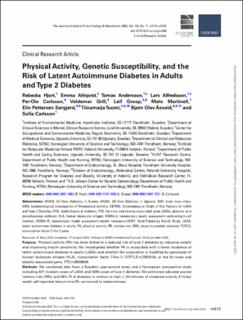| dc.contributor.author | Hjort, Rebecka | |
| dc.contributor.author | Ahlqvist, Emma | |
| dc.contributor.author | Andersson, Tomas | |
| dc.contributor.author | Alfredsson, Lars | |
| dc.contributor.author | Carlsson, Per-Ola | |
| dc.contributor.author | Grill, Valdemar Erik Robert | |
| dc.contributor.author | Groop, Leif | |
| dc.contributor.author | Martinell, Mats | |
| dc.contributor.author | Sørgjerd, Elin Pettersen | |
| dc.contributor.author | Tuomi, Tiinamaija | |
| dc.contributor.author | Åsvold, Bjørn Olav | |
| dc.contributor.author | Carlsson, Sofia | |
| dc.date.accessioned | 2021-04-28T08:15:43Z | |
| dc.date.available | 2021-04-28T08:15:43Z | |
| dc.date.created | 2020-10-13T10:56:44Z | |
| dc.date.issued | 2020 | |
| dc.identifier.citation | Journal of Clinical Endocrinology and Metabolism. 2020, 105 (11), . | en_US |
| dc.identifier.issn | 0021-972X | |
| dc.identifier.uri | https://hdl.handle.net/11250/2740070 | |
| dc.description.abstract | Purpose
Physical activity (PA) has been linked to a reduced risk of type 2 diabetes by reducing weight and improving insulin sensitivity. We investigated whether PA is associated with a lower incidence of latent autoimmune diabetes in adults (LADA) and whether the association is modified by genotypes of human leukocyte antigen (HLA), transcription factor 7-like 2 (TCF7L2)-rs7903146, or the fat mass and obesity-associated gene, FTO-rs9939609.
Methods
We combined data from a Swedish case-control study and a Norwegian prospective study including 621 incident cases of LADA and 3596 cases of type 2 diabetes. We estimated adjusted pooled relative risks (RRs) and 95% CI of diabetes in relation to high (≥ 30 minutes of moderate activity 3 times/week) self-reported leisure time PA, compared to sedentariness.
Results
High PA was associated with a reduced risk of LADA (RR 0.61; CI, 0.43-0.86), which was attenuated after adjustment for body mass index (BMI) (RR 0.90; CI, 0.63-1.29). The reduced risk applied only to noncarriers of HLA-DQB1 and -DRB1 (RR 0.49; CI, 0.33-0.72), TCF7L2 (RR 0.62; CI, 0.45-0.87), and FTO (RR 0.51; CI, 0.32-0.79) risk genotypes. Adjustment for BMI attenuated but did not eliminate these associations. For type 2 diabetes, there was an inverse association with PA (RR 0.49; CI, 0.42-0.56), irrespective of genotype.
Main Conclusions
Our findings indicate that high PA is associated with a reduced risk of LADA in individuals without genetic susceptibility. | en_US |
| dc.language.iso | eng | en_US |
| dc.publisher | Oxford University Press | en_US |
| dc.rights | Navngivelse 4.0 Internasjonal | * |
| dc.rights | Navngivelse 4.0 Internasjonal | * |
| dc.rights.uri | http://creativecommons.org/licenses/by/4.0/deed.no | * |
| dc.title | Physical Activity, Genetic Susceptibility, and the Risk of Latent Autoimmune Diabetes in Adults and Type 2 Diabetes | en_US |
| dc.type | Peer reviewed | en_US |
| dc.type | Journal article | en_US |
| dc.description.version | publishedVersion | en_US |
| dc.source.pagenumber | 0 | en_US |
| dc.source.volume | 105 | en_US |
| dc.source.journal | Journal of Clinical Endocrinology and Metabolism | en_US |
| dc.source.issue | 11 | en_US |
| dc.identifier.doi | 10.1210/clinem/dgaa549 | |
| dc.identifier.cristin | 1839122 | |
| cristin.ispublished | true | |
| cristin.fulltext | original | |
| cristin.qualitycode | 2 | |

